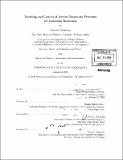| dc.contributor.advisor | Hamsa Balakrishnan. | en_US |
| dc.contributor.author | Simaiakis, Ioannis | en_US |
| dc.contributor.other | Massachusetts Institute of Technology. Technology and Policy Program. | en_US |
| dc.date.accessioned | 2010-09-02T17:23:55Z | |
| dc.date.available | 2010-09-02T17:23:55Z | |
| dc.date.copyright | 2009 | en_US |
| dc.date.issued | 2009 | en_US |
| dc.identifier.uri | http://hdl.handle.net/1721.1/58289 | |
| dc.description | Thesis (S.M.)--Massachusetts Institute of Technology, Dept. of Aeronautics and Astronautics; and, (S.M. in Technology and Policy)--Massachusetts Institute of Technology, Engineering Systems Division, Technology and Policy Program, 2009. | en_US |
| dc.description | Cataloged from PDF version of thesis. | en_US |
| dc.description | Includes bibliographical references (p. 139-141). | en_US |
| dc.description.abstract | Taxiing aircraft contribute significantly to the fuel burn and emissions at airports. This thesis investigates the possibility of reducing fuel burn and emissions from surface operations through a reduction of the taxi times of departing aircraft. Data analysis of the departing traffic in four major US airports provides a comprehensive assessment of the impact of surface congestion on taxi times, fuel burn and emissions. For this analysis two metrics are introduced: one that compares the taxi times to the unimpeded ones and another that evaluates them in terms of their contribution to the airport's throughput. A novel approach is proposed that models the aircraft departure process as a queuing system. The departure taxi (taxi-out) time of an aircraft is represented as a sum of three components: the unimpeded taxi-out time, the time spent in the departure queue, and the congestion delay due to ramp and taxiway interactions. The dependence of the taxi-out time on these factors is analyzed and modeled. The performance of the model is validated through a comparison of its predictions with observed data at Boston's Logan International Airport (BOS). A reduction in taxi times may be achieved through the queue management strategy known as N-Control, which controls the push back process so as to keep the number of departing aircraft on the surface of the airport below a specified threshold. The developed model is used to quantify the impact of N-Control on taxi times, delays, fuel burn and emissions at BOS. Finally, the benefits and implications of N-Control are compared to the ones theoretically achievable from a scheme that controls the takeoff queue of each departing aircraft. | en_US |
| dc.description.statementofresponsibility | by Ioannis Simaiakis. | en_US |
| dc.format.extent | 141 p. | en_US |
| dc.language.iso | eng | en_US |
| dc.publisher | Massachusetts Institute of Technology | en_US |
| dc.rights | M.I.T. theses are protected by
copyright. They may be viewed from this source for any purpose, but
reproduction or distribution in any format is prohibited without written
permission. See provided URL for inquiries about permission. | en_US |
| dc.rights.uri | http://dspace.mit.edu/handle/1721.1/7582 | en_US |
| dc.subject | Aeronautics and Astronautics. | en_US |
| dc.subject | Engineering Systems Division. | en_US |
| dc.subject | Technology and Policy Program. | en_US |
| dc.title | Modeling and control of airport departure processes for emissions reduction | en_US |
| dc.type | Thesis | en_US |
| dc.description.degree | S.M.in Technology and Policy | en_US |
| dc.description.degree | S.M. | en_US |
| dc.contributor.department | Massachusetts Institute of Technology. Department of Aeronautics and Astronautics | |
| dc.contributor.department | Massachusetts Institute of Technology. Engineering Systems Division | |
| dc.contributor.department | Technology and Policy Program | |
| dc.identifier.oclc | 650350220 | en_US |
